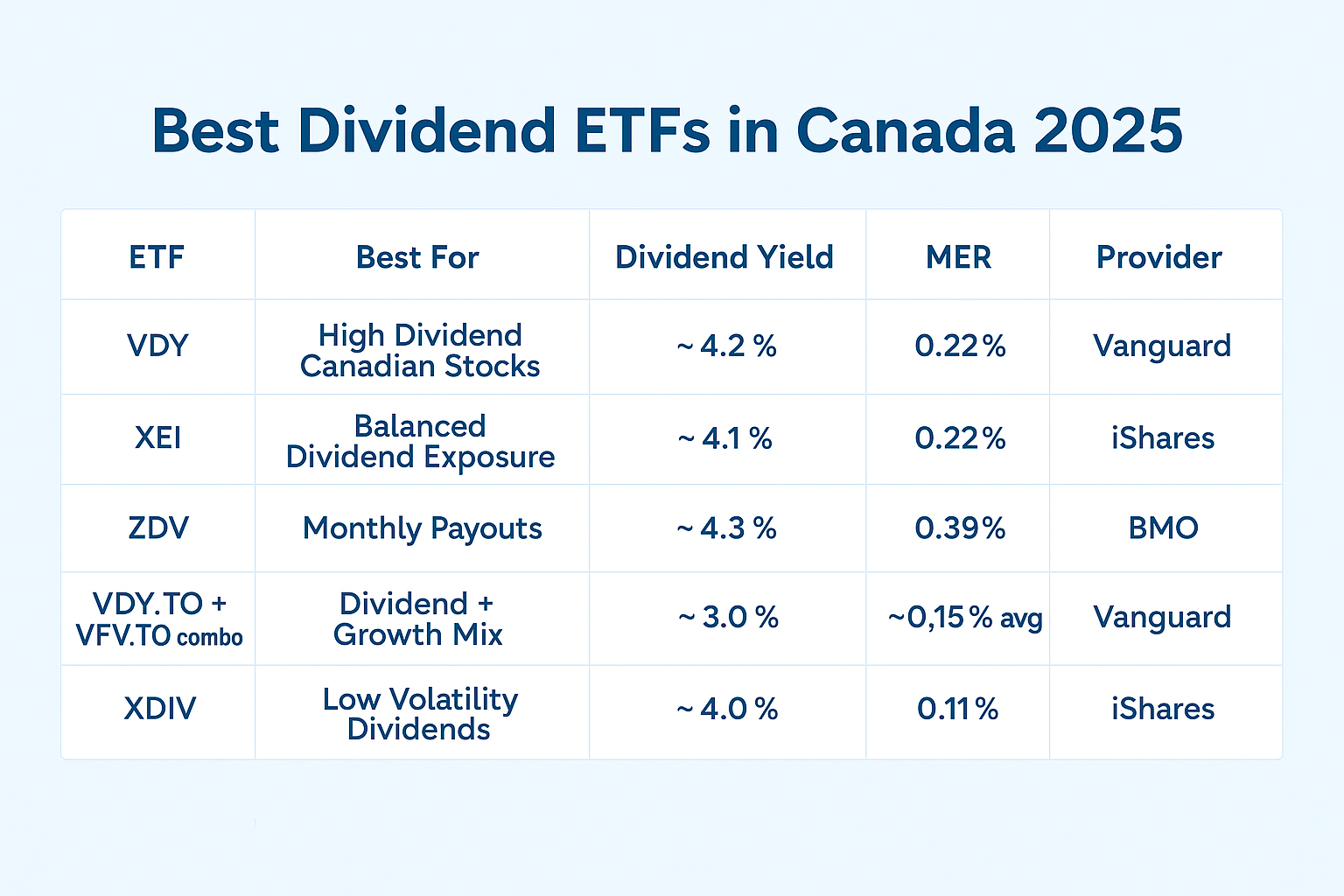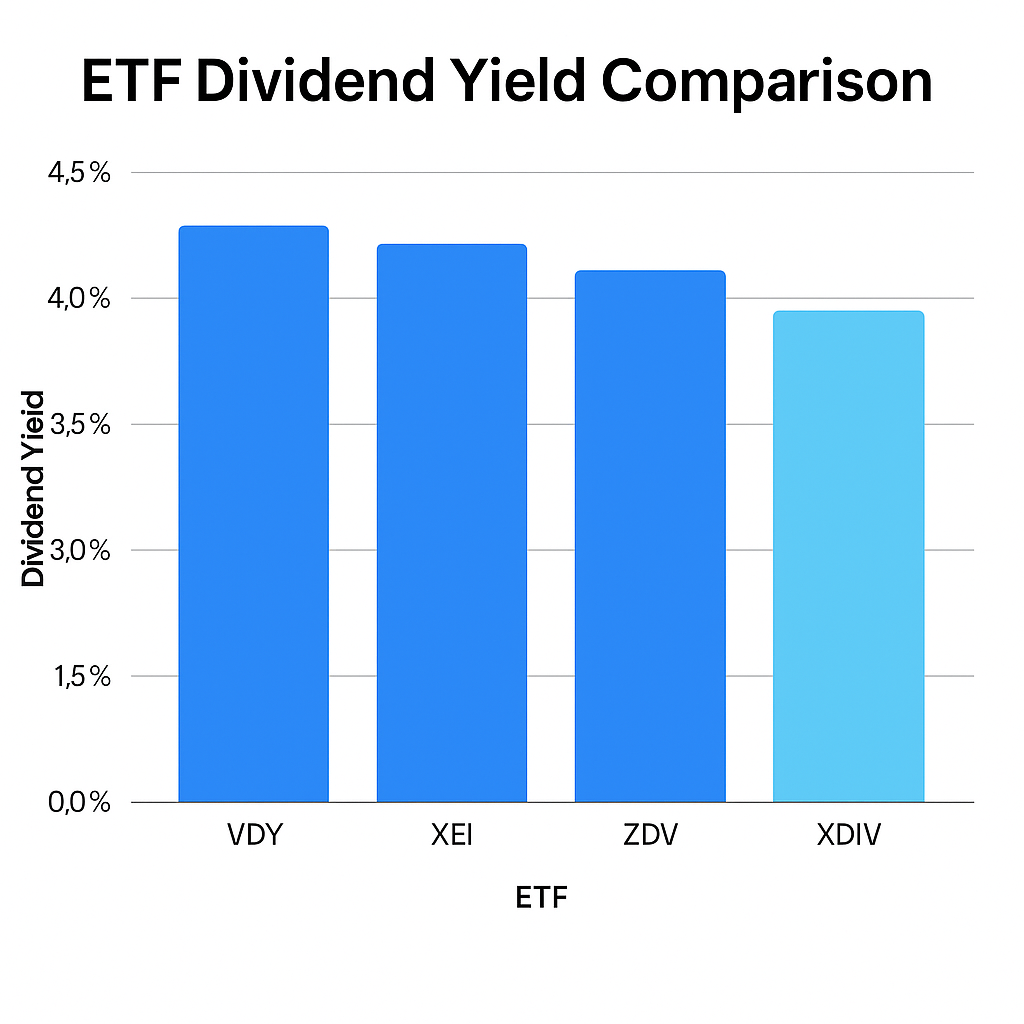Best Dividend ETFs in Canada 2025
“Updated October 2025 – Added new data and recommendations.”
Disclosure: This post may contain affiliate links. We may earn a commission if you sign up through our links, at no extra cost to you.

Introduction
Dividend ETFs are the ultimate “get paid to wait” strategy, steady income, solid growth, and low fees.
A dividend ETF bundles dozens of dividend-paying stocks into a single investment. Instead of buying individual companies like RBC or Enbridge, you can own them all at once, and collect regular payouts.
Canadians love dividend ETFs because they provide:
- Passive income without stock picking
- Tax efficiency in TFSAs and RRSPs
- Diversification across reliable, income-producing sectors
In this guide, we’ll break down the best dividend ETFs in Canada 2025, including yield, performance, and which accounts (TFSA, RRSP, or taxable) they fit best.
For broader ETF ideas, check out Best ETFs for Canadian Investors in 2025.
Comparison Table – Best Dividend ETFs in Canada 2025

1. VDY – Vanguard FTSE Canadian High Dividend Yield Index ETF
Why It Stands Out
VDY focuses on Canada’s largest dividend-paying companies, banks, telecoms, and energy firms like RBC, BCE, and Enbridge.
It’s ideal for long-term investors who want steady cash flow and exposure to blue-chip Canadian stocks.
Pros
- High yield (~4.2%)
- Reliable Canadian dividend payers
- Perfect for TFSA or RRSP accounts
- Simple, low-maintenance holding
Cons
- Sector concentration (heavily banks/energy)
Invest in VDY with Wealthsimple
Personal Note
“I personally hold VDY for passive income. It’s predictable, diversified, and pays me every quarter, no micromanaging needed.”
2. XEI – iShares Core S&P/TSX Composite High Dividend ETF
Why It Stands Out
XEI offers broader coverage than VDY, including utilities and pipelines, while maintaining a solid 4% yield.
Pros
- More diversified than VDY
- Consistent dividend performance
- Balanced across sectors
Cons
- Slightly lower growth potential than VFV or XEQT
3. ZDV – BMO Canadian Dividend ETF
Why It Stands Out
ZDV pays monthly distributions, making it a great option for retirees or anyone who values predictable cash flow.
Pros
- Monthly payouts
- Strong dividend yield (~4.3%)
- Established provider (BMO)
Cons
- Higher MER (0.39%)
- Limited global diversification

4. XDIV – iShares Core MSCI Canadian Quality Dividend ETF
Why It Stands Out
XDIV focuses on stable, high-quality dividend-paying companies with low volatility. It’s an excellent fit for long-term TFSA investors.
Pros
- Low fee (0.11%)
- Emphasis on quality and stability
- Balanced yield and growth
Cons
- Less yield than ZDV but more stability
5. Dividend + Growth Combo (VDY + VFV)
Why It Stands Out
Combining VDY (Canadian dividends) with VFV (U.S. S&P 500 growth) gives investors both consistent income and long-term performance potential.
Pros
- Diversified across Canadian and U.S. markets
- Balanced blend of growth + dividends
- Simple two-ETF strategy
Cons
- Requires managing two ETFs instead of one
Start investing with Questrade (nofollow, sponsored)
How to Choose the Right Dividend ETF
When picking the best dividend ETF for your portfolio, consider:
- Your goal: Do you want income now or growth later?
- Yield vs. diversification: Higher yield often means more concentration.
- Account type: Use a TFSA for tax-free growth or an RRSP to avoid U.S. withholding taxes.
- Fees (MER): Lower MER = more profit kept.
All of the ETFs above are available on platforms like Wealthsimple Trade and Questrade.
FAQs
Q: Are dividend ETFs good for beginners?
Yes, they’re diversified, simple, and automatically manage your income stream.
Q: Can I hold dividend ETFs in my TFSA?
Absolutely. TFSAs and RRSPs are ideal for avoiding taxes on your dividends.
Q: How are ETF dividends taxed in Canada?
Canadian dividends receive a tax credit in taxable accounts. U.S. dividends are subject to a 15% withholding tax unless held in an RRSP.
Q: How often do dividend ETFs pay?
Most pay quarterly, while some (like ZDV) pay monthly.

Conclusion
Dividend ETFs are one of the simplest and most powerful ways for Canadians to build steady wealth. They provide passive income, diversification, and long-term growth, without the work of picking individual stocks.
For pure income, VDY and ZDV stand out. For growth and global exposure, combine VDY + VFV for a balanced long-term portfolio.
Start building your passive income portfolio today with Wealthsimple or Questrade.

